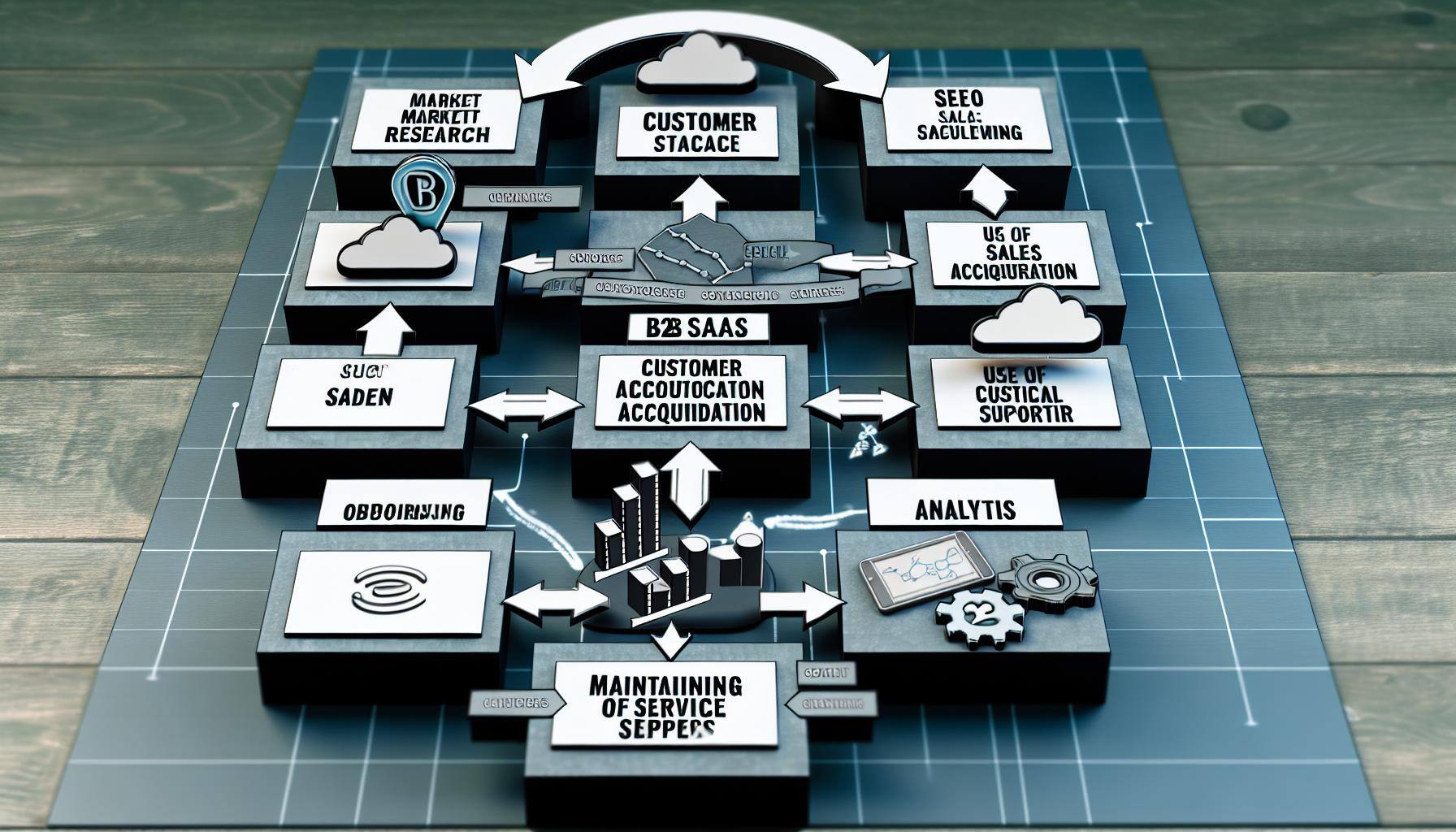Top 5 B2B SaaS Growth Challenges in 2024 and How to Tackle Them
The B2B SaaS industry continues to evolve at a rapid pace, necessitating innovative strategies to overcome the myriad of challenges inherent to...
6 min read
Brian Polackoff
:
Aug 23, 2024 11:42:00 AM

Building a successful B2B SaaS (Business-to-Business Software as a Service) company requires a strategic approach and an in-depth understanding of the market dynamics, customer needs, and key business processes. B2B SaaS businesses deliver software solutions to other businesses, making it essential for SaaS founders to create a robust business plan, adopt effective marketing strategies, optimize customer acquisition, and ensure excellent customer support and onboarding processes.
Identifying a profitable target market is a critical first step for any B2B SaaS startup. The process starts with thorough market research to understand the demand for specific SaaS solutions within various industries. A B2B SaaS company must analyze industry trends, competitor offerings, and potential gaps in the market. By defining a clear target market, SaaS founders can tailor their product development efforts to meet the specific needs and preferences of potential customers, thereby increasing the likelihood of adoption and success.
Understanding potential customers is paramount to building a successful B2B SaaS business. This involves collecting data about their pain points, business processes, and decision-making criteria to make your product valuable. Surveys, interviews, and focus groups with potential B2B customers can provide valuable insights for planning to develop a SaaS. Additionally, leveraging analytics to examine customer behavior and preferences can help SaaS founders refine their products to better align with market demands. This research will inform the product development process and shape marketing strategies to effectively address the needs of the target audience.
Developing a Minimum Viable Product (MVP) is a crucial step in the journey of a SaaS startup. An MVP is a basic version of the B2B software as a service product that includes only the core features necessary to solve the primary problem of the target market when planning to develop a SaaS. The purpose of an MVP is to test the product in the real market with actual users, gather feedback, and make necessary improvements before a full-scale launch in creating a successful B2B SaaS. A successful MVP helps validate the business idea, minimize initial development costs, and reduce risks associated with launching a new software offering.
Content marketing is a powerful tool for B2B SaaS companies to attract and engage potential B2C SaaS customers. Creating effective content marketing strategies involves producing high-quality, relevant content that addresses the needs and pain points of B2B customers. Blog posts, whitepapers, case studies, and webinars can educate potential users about the benefits of the SaaS product and demonstrate thought leadership in the industry. A well-executed content marketing plan can establish trust and credibility, ultimately driving customer acquisition and retention in a successful B2B SaaS growth strategy.
Search Engine Optimization (SEO) plays a pivotal role in building a B2B SaaS by improving the visibility and discoverability of the SaaS product online. Effective SEO strategies involve optimizing the website and content for relevant keywords, building high-quality backlinks, and ensuring a seamless user experience. By ranking higher in search engine results, SaaS companies can attract more organic traffic, reach a broader audience, and generate qualified leads. SEO is an ongoing process that requires continuous monitoring and adjustments to stay ahead in the competitive SaaS market, especially when you’re looking to launch a SaaS.
Social media platforms offer valuable opportunities for B2B SaaS companies to connect with their target audience, build brand awareness, and foster engagement. Leveraging social media for B2B SaaS marketing involves creating and sharing content that resonates with potential customers, participating in industry conversations, and utilizing paid advertising options. LinkedIn, in particular, is a powerful platform for B2B marketing, allowing SaaS businesses to target specific industries and decision-makers. Consistent and strategic social media activities can enhance the overall marketing efforts and support customer acquisition goals.
Reducing customer acquisition cost (CAC) is essential for optimizing the profitability of a SaaS business. Best practices for lowering CAC include improving lead generation efficiency, refining the sales funnel, and enhancing the effectiveness of marketing campaigns. Implementing automated marketing tools and CRM systems can streamline the process and reduce manual efforts for the marketing team. Additionally, focusing on customer retention through excellent service and support can lead to organic growth and referrals, further decreasing the need for high acquisition spending when you’re looking to start a SaaS company.
Analytics play a crucial role in optimizing customer acquisition for many SaaS businesses. By leveraging data analytics, companies can gain insights into the performance of their marketing and sales efforts, identify successful channels, and understand customer behaviors. Analyzing metrics such as conversion rates, customer lifetime value, and churn rates enables top SaaS founders to make data-driven decisions and allocate resources more effectively. Advanced analytics tools can also help in identifying trends and opportunities for improvement, ensuring a focused and efficient customer acquisition strategy to sell SaaS.
Building a strong sales funnel is vital for converting leads into paying customers in a B2B SaaS business that’s focused on providing value. The sales funnel should be designed to guide potential customers through the stages of awareness, interest, consideration, and decision when starting a SaaS business. Effective sales and marketing alignment, personalized outreach, and tailored content can nurture leads and address their specific needs at each stage of creating a successful B2B SaaS. Additionally, leveraging CRM systems and automated workflows can streamline the process and enhance the efficiency of the sales team in many SaaS startups. A well-defined sales funnel ensures a smooth journey for prospects and maximizes the chances of conversion as the company grows.
Scaling a B2B SaaS company involves addressing various technical challenges to ensure that the infrastructure can handle increased demand. Key technical pain points include optimizing software performance, enhancing security measures, and ensuring scalability of the architecture. Investing in robust software development practices, cloud-based solutions, and continuous monitoring can help mitigate these challenges. SaaS companies must prioritize seamless user experience and maintain high levels of uptime and reliability to retain and attract customers as the company grows.
As a B2B SaaS company scales, managing increased customer support needs becomes a critical aspect of maintaining customer satisfaction and loyalty. Implementing scalable customer support solutions such as AI-powered chatbots, knowledge bases, and ticketing systems can help handle higher volumes of inquiries efficiently. Training and expanding the customer support team to ensure they are well-equipped to address complex issues is essential. Proactive communication, regular follow-ups, and gathering feedback can also enhance the overall customer support experience, fostering long-term relationships with clients.
Maintaining service quality while scaling is a significant challenge for B2B SaaS companies, especially when starting a SaaS business. As the customer base grows, it is crucial to ensure that the SaaS product continues to deliver consistent performance and value to maintain a successful B2B SaaS company that’s focused on customer retention. Regular updates, rigorous testing, and continuous monitoring are necessary to identify and resolve any issues promptly. Implementing best practices in software development, such as Agile methodologies, can help maintain high-quality standards in creating a successful B2B SaaS company. Additionally, customer feedback loops and satisfaction surveys can provide insights into areas for improvement, ensuring that the service quality remains top-notch.
Successful onboarding is vital for ensuring that new customers derive maximum value from the B2B SaaS product promptly. Best practices for onboarding include creating a structured onboarding process that involves personalized training sessions, step-by-step guides, and interactive tutorials to make your product user-friendly. Providing dedicated onboarding managers or customer success teams can offer hands-on assistance and address any initial challenges that new users may face, enhancing the overall customer experience when you’re looking to start a SaaS company. Clear communication of the product's features, benefits, and how-to guides can help customers improve their customer experience and become proficient with the SaaS solution.
Measuring the effectiveness of the onboarding process is essential to identify areas for improvement and ensure that new B2B customers are successfully integrated into the successful B2B SaaS company. Key metrics to track include time-to-value, customer engagement levels, and churn rates, especially when it comes to B2B SaaS. Surveys and feedback forms can gather direct input from users about their onboarding experience. Analyzing these metrics and feedback can provide insights into the onboarding process's strengths and weaknesses, enabling SaaS companies to refine and enhance their approach for better customer satisfaction and retention.
Various tools and techniques can enhance the onboarding experience for new B2B customers in a successful SaaS offering. Utilizing onboarding software solutions that offer automated workflows, personalized learning paths, and progress tracking can streamline the process for many SaaS startups. Interactive tutorials, video guides, and in-app messaging can provide real-time support and guidance. Gamification elements such as badges and rewards can make the onboarding process more engaging and enjoyable for users of a successful SaaS offering. By leveraging these tools and techniques, SaaS companies can ensure a smooth and effective onboarding experience, leading to higher customer satisfaction and long-term success.

The B2B SaaS industry continues to evolve at a rapid pace, necessitating innovative strategies to overcome the myriad of challenges inherent to...

Customer churn represents a critical challenge for B2B SaaS companies. Churn occurs when customers stop using a product or service, leading to lost...

In the highly competitive B2B SaaS market, churn rate is more than just a key performance indicator for your management team—it's a crucial metric...